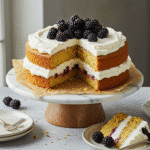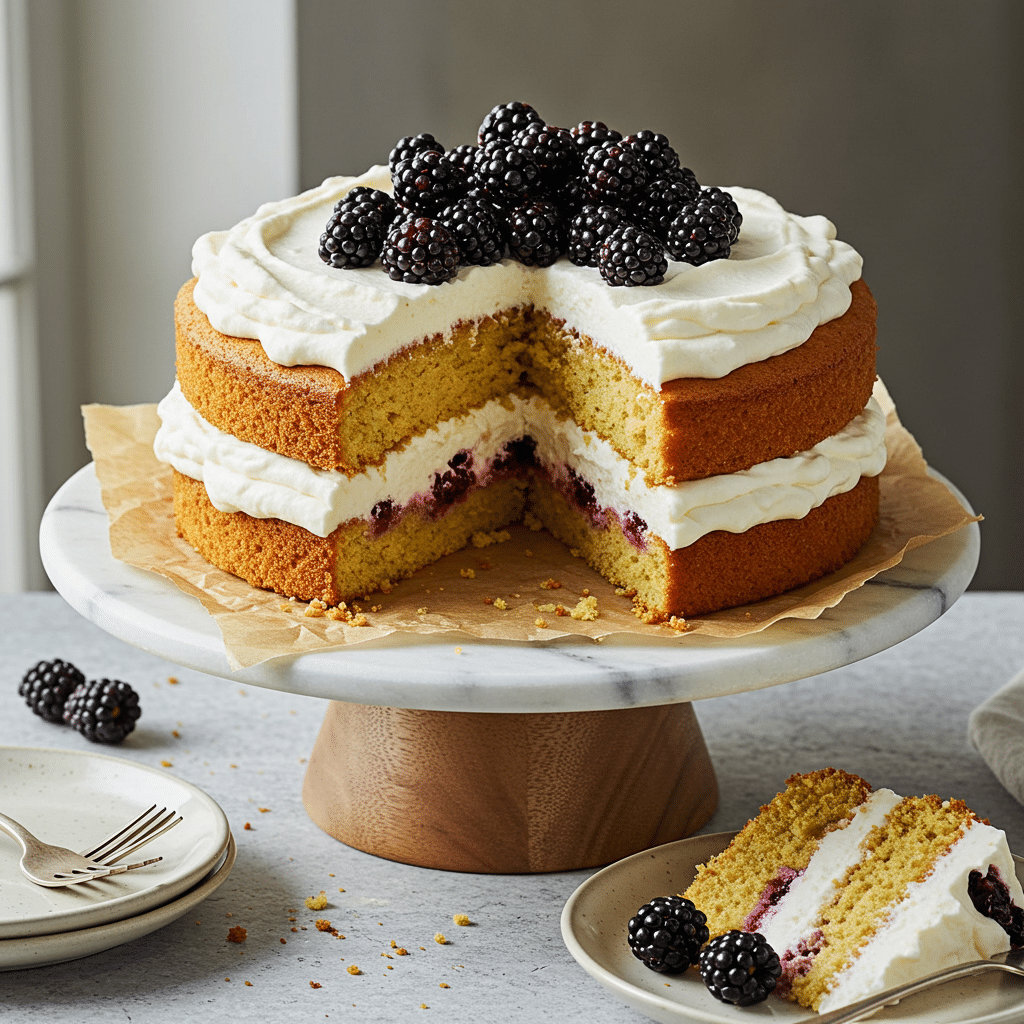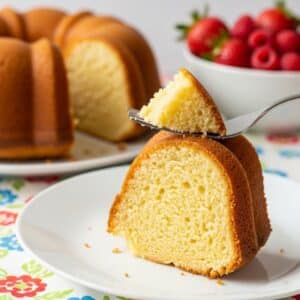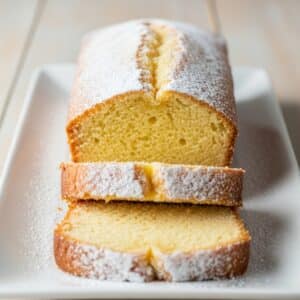Baking a Lemon Blackberry Cake is one of the best ways to combine bright citrus with juicy fruit in a dessert that feels light but still indulgent. This cake features a tender lemon sponge layered with macerated blackberries and topped with mascarpone whipped cream mixed with lemon curd. It looks elegant when sliced, yet it is simple enough to prepare at home with basic tools.
Each layer plays a role: the sponge adds structure, the berries bring color and juiciness, and the cream ties everything together with smooth richness. Whether you are planning a family gathering, a casual dinner, or a celebration, this cake offers both taste and presentation that impress without being intimidating. The balance of tart lemon and sweet blackberries keeps every bite refreshing, while the cream ensures a soft, luscious finish.
🧾 Want to keep this recipe for later? Download your printable PDF version now and enjoy it anytime!
📥 Download Recipe PDF✅ Print-friendly • 🕒 Save for later • 📱 Mobile-accessible
💡 Want more like this? Subscribe to our weekly printable recipes!
Over the next sections, you will learn about ingredient selection, proper preparation of the batter, careful baking, making the fillings, and assembling the layers. With clear steps and helpful tips, this recipe becomes approachable even if you are new to baking layer cakes. By the end, you will not only have a beautiful cake but also a reliable process you can use again and again.
The Perfect Flavor Combination
Why Lemon and Blackberries Shine Together
Lemon and blackberries form a pairing that works on multiple levels. Lemon provides sharpness and brightness, while blackberries contribute a juicy sweetness with just a touch of tartness. This contrast keeps the flavor balanced and prevents the cake from feeling overly sweet. The visual appeal is equally important. Blackberries stand out against the pale sponge, creating dramatic slices that look beautiful on any table. Together, these flavors and colors make the dessert memorable before the first bite.
How to Highlight the Flavors in Baking
To bring out the best in lemon, rub zest into sugar until it becomes fragrant. This step releases oils that carry flavor deeper into the batter. Blackberries should be tossed lightly with flour before folding into the batter, which prevents them from sinking and ensures even distribution. The addition of mascarpone whipped cream with lemon curd enhances the citrus while complementing the berries with richness. These small steps ensure that both ingredients shine equally in the final cake. When combined thoughtfully, the result is a dessert that balances freshness, sweetness, and indulgence perfectly.
Print
Lemon Blackberry Cake Recipe
- Total Time: 1 hour 20 minutes
- Yield: 10 servings 1x
- Diet: Vegetarian
Description
A moist lemon sponge layered with macerated blackberries and topped with a lemon curd mascarpone whipped cream. A refreshing, indulgent dessert perfect for celebrations.
Ingredients
150 g granulated sugar
1 lemon zested
1/2 tsp fine sea salt
150 g all-purpose flour + 15 g for blackberries
1/2 tsp baking soda
1/2 tsp baking powder
2 large eggs, room temperature
125 g unsalted butter, soft
100 g full-fat Greek yogurt
1 tsp vanilla extract
150 g blackberries, fresh or frozen
Blackberry Filling
250 g blackberries, fresh or frozen
1/2 lemon, juiced
2 tbsp granulated sugar
Lemon Curd Mascarpone Cream
3 egg yolks
90 g granulated sugar
1 lemon zested
60 g lemon juice
1/4 tsp fine sea salt
225 g mascarpone (8 oz)
200 g cold heavy cream
Instructions
1. Preheat oven to 350°F and grease a springform pan.
2. Rub lemon zest into sugar until fragrant, then whisk in flour, salt, baking soda, and baking powder.
3. Add butter, yogurt, eggs, and vanilla. Mix until just combined.
4. Coat blackberries in flour, fold gently into batter, and pour into pan.
5. Bake 30 minutes, rotate, then bake 20–25 minutes more until toothpick comes out clean.
6. Cool 10 minutes, release pan, and let sponge cool completely.
7. Macerate blackberries with sugar and lemon juice. Mash half if fresh, leave thawed if frozen.
8. Whisk yolks, sugar, zest, juice, and salt over simmering water until thick. Add mascarpone spoon by spoon. Chill.
9. Whip cream to soft peaks, fold into chilled curd to make mascarpone cream.
10. Slice sponge into 2 layers. Spread half cream, add macerated blackberries, then top with second sponge.
11. Spread remaining cream on top, swirl in lemon curd, and decorate with blackberries.
12. Chill 1–2 hours before slicing for best results.
Notes
To scale into a 9” cake, multiply sponge ingredients by 1.5.
Cake can be prepared over 2 days: bake sponge and make fillings one day, assemble the next.
Frozen blackberries are recommended for the filling because they soften nicely when macerated.
- Prep Time: 25 minutes
- Cook Time: 55 minutes
- Category: Dessert
- Method: Baking
- Cuisine: Canadian
Nutrition
- Serving Size: 1 slice
- Calories: 320
- Sugar: 25g
- Sodium: 160mg
- Fat: 18g
- Saturated Fat: 10g
- Unsaturated Fat: 6g
- Trans Fat: 0g
- Carbohydrates: 36g
- Fiber: 3g
- Protein: 6g
- Cholesterol: 85mg
Choosing the Best Ingredients
Essentials for the Sponge
The sponge depends on a few carefully chosen ingredients. Fresh lemons provide zest and juice with more intensity than bottled alternatives. Greek yogurt, with its fat content, keeps the cake moist while also lending a slight tang. Unsalted butter allows precise control of salt levels, while fresh baking soda and baking powder ensure proper rise. Eggs at room temperature mix more evenly, giving the sponge its light texture. Flour should be all-purpose for structure without heaviness. Each choice contributes to a sponge that is flavorful, tender, and reliable.
Selecting Fruits and Creams
Blackberries should be ripe and flavorful, though frozen berries also work well when macerated. Their juiciness adds contrast to the sponge’s structure. For cream, mascarpone is ideal because of its mild flavor and smooth texture, which blends easily with lemon curd. Heavy cream provides volume and stability, while sugar balances the tartness of lemon. These ingredients, when combined, create a topping that is rich but not heavy. If you enjoy other citrus desserts, you might also appreciate this Citrus Olive Oil Cake recipe for another refreshing option. Using high-quality fruits and dairy is what transforms this recipe from simple to special.
Mixing and Baking the Sponge
Proper Mixing Techniques
Mixing the sponge requires attention to avoid toughness. Begin with the sugar and lemon zest, rubbing them together until the sugar clumps lightly. Add flour, baking powder, baking soda, and salt, whisking gently. Next, introduce softened butter, yogurt, eggs, and vanilla. Mix slowly until combined, then briefly at higher speed to aerate. Scrape the bowl to prevent unmixed pockets of flour or butter. The batter should be smooth but not overmixed. Fold in the flour-coated blackberries carefully to avoid breaking them. A light hand keeps the batter airy, resulting in a soft sponge with evenly distributed fruit.
Baking to the Right Texture
Transfer the batter to a greased springform pan, smoothing the surface with a spatula. Bake at 350°F in the middle rack for about 30 minutes, then rotate the pan for even browning. Continue baking for another 20 to 25 minutes. Test with a toothpick; it should come out clean or with a few moist crumbs. Let the cake cool in the pan for ten minutes, then release the springform. Place the cake on a rack and cool completely before slicing or layering. This cooling step is essential, as frosting a warm cake would cause the cream to melt and the structure to collapse.
Preparing the Blackberries
Macerating for Flavor
Macerating blackberries brings out natural juices and enhances their sweetness. Combine the berries with sugar and a splash of lemon juice in a bowl. Let them rest at room temperature until they release syrup. If preparing in advance, refrigerate them overnight. Fresh berries benefit from mashing half with a fork to create a spreadable filling, while frozen berries usually soften enough as they thaw. Macerated berries not only taste brighter but also add visual appeal, with their glossy finish and deep purple color contrasting the pale sponge and creamy layers beautifully.
Using Them in the Cake
When layering, drain excess liquid from the macerated berries to prevent sogginess. Spread mashed berries in the middle layer of the cake and scatter whole berries on top for bursts of juiciness. Keep the distribution even for consistent flavor in every slice. Save some of the syrup to drizzle lightly over the finished cake if desired. The berries play a key role in both taste and presentation, giving freshness and vibrancy to every portion. They ensure the cake is not just rich with cream but balanced with fruitiness.
Making the Lemon Curd Mascarpone Cream
Preparing the Lemon Curd Base
Start by whisking egg yolks, sugar, lemon zest, juice, and a pinch of salt in a heatproof bowl. Place the bowl over simmering water and whisk constantly until the mixture thickens to a mayonnaise-like texture. This takes careful timing, as too much heat can scramble the eggs. Remove the bowl from the heat once thick and add cold mascarpone in small spoonfuls, whisking each addition until smooth. Cover the mixture with plastic pressed against the surface to prevent a skin from forming, then refrigerate until cold and set.
Finishing the Cream
Once the curd has chilled, whip heavy cream until soft peaks form. Fold the cream into the curd gradually, first half, then the other half. This folding process preserves the air in the cream while blending it with the lemon base. The final mixture is smooth, light, and stable enough to spread between layers or swirl on top. The cream balances tart lemon with richness, acting as both filling and decoration. Its consistency makes it easy to work with while keeping the cake refreshing rather than heavy, ensuring that each slice feels indulgent but not overly rich.
Assembling the Cake
Layering for Balance
After cooling, slice the sponge into two layers using a serrated knife. Place the bottom layer on a serving plate or stand. Spread a generous portion of lemon mascarpone cream across the surface, then scatter mashed and whole macerated blackberries evenly. Top with the second sponge layer, pressing gently to secure. Spread the remaining cream over the top, creating rustic swirls with a spoon. Add extra lemon curd for decoration, swirling it into the cream. Finish by arranging the remaining macerated blackberries on top. This assembly process creates contrast in flavor and color that makes the cake stand out.
Serving with Style
Refrigerate the cake for at least an hour before slicing. This chilling time helps the cream set, making cleaner slices. For neat presentation, wipe the knife between cuts. Serve the cake chilled for firmer texture or allow it to come to room temperature for softer cream. Pair slices with tea or coffee for a balanced experience. Leftovers keep well in the fridge for several days. For larger occasions, double the recipe and bake two thinner sponges for taller layers. Presentation tips like neat cream edges and even berry placement ensure your cake looks as professional as it tastes.
FAQs about Lemon Blackberry Cake
Can I use frozen blackberries? Yes, frozen blackberries are excellent. Toss them with flour before adding to the batter and macerate them after thawing for the filling.
Can I prepare this cake in advance? Bake the sponge, macerate the berries, and make the curd a day before. Assemble the layers the next day for the freshest results.
What can I substitute for mascarpone? Cream cheese works as a substitute, though it adds tang. Ricotta, blended smooth, can also be used for a lighter texture.
Is it possible to make this cake gluten-free? Yes, substitute a 1:1 gluten-free flour blend. The yogurt in the sponge helps maintain tenderness.
How should leftovers be stored? Keep the cake covered in the refrigerator for up to three days. For longer storage, freeze individual slices and thaw in the fridge overnight.
Conclusion
Lemon Blackberry Cake is a dessert that balances bright citrus, juicy berries, and creamy richness in every slice. By carefully preparing the sponge, macerating the fruit, and crafting a smooth mascarpone cream, you create a cake that is both beautiful and delicious. It works equally well for casual gatherings or more formal celebrations, offering flavor and presentation that stand out.
With straightforward ingredients and clear steps, this recipe is accessible even for newer bakers. The final result is a cake that looks impressive, slices neatly, and tastes unforgettable. Once you try it, you will find yourself returning to this recipe whenever you want to serve something refreshing and memorable.




